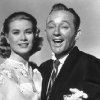“There’s a lot of fancy words in this town.”
1939 was just a good year for movies. Two beloved classics, Gone With the Wind and The Wizard of Oz (both of which we’ll get to later), were released in this year. However, there was another gem to come out of ’39: the dramatic, powerful, unabashedly patriotic Mr. Smith Goes to Washington.
When Frank Capra and Jimmy Stewart pair up, you can’t go wrong. A subject that might seem slightly dull on the outset is instantly illuminated by the professionalism and expertise of both the director and the leading man. While by modern definition the film isn’t epic, it is certainly powerful. Brace yourself for a cliché: they just don’t make ’em like they used to.
Although politics are considerably more aggressive now than they were in ’39, the topic was just as popular and controversial in those days. Capra pulls it off with grace, and the undeniably likable Stewart just increases the appeal. There are some surprisingly profound lines concerning Washington, corruption, patriotism, and the country itself.
However, Mr. Smith is not entirely solemn and somber. There are actually some priceless comedic moments, thanks to the awkwardness of our beloved Jimmy. The chemistry between Stewart and Jean Arthur is also fantastic.
As I’ve further familiarized myself with his filmography, I find that Jimmy Stewart can display a rather wide range of emotions. In Shenandoah, he’s a crusty, disagreeable Virginia landowner, who experiences terrible loss. In The Philadelphia Story, he’s a hilarious, awkward tabloid reporter. But in Mr. Smith, he’s an idealistic small-towner who just wants his voice heard. He plays all three of these characters to perfection.
Synopsis
I could talk forever, but I suppose I should give you the synopsis now. Sorry.
Naive Jefferson Smith (Stewart), leader of the Boy Rangers, is appointed to the Senate on a lark by the vacillating, malleable governor of his state. He is reunited with the state’s senior senator–presidential hopeful and Smith’s childhood hero, Senator Joseph Paine (Claude Rains). In Washington, however, Smith’s expectations are soon depleted by the harsh reality of politics. He discovers many of the shortcomings of the political process as his earnest goal of a national boys’ camp leads to a conflict with the hateful state political boss, Jim Taylor. Taylor first tries to corrupt Smith and then later attempts to destroy Smith with a scandal.
Information
Check this out:
Directed by Frank Capra;
Written by Lewis R. Foster (story), and Sydney Buchman (screenplay);
Starring James Stewart as Jefferson Smith, Jean Arthur as Clarissa Saunders, and Claude Rains as Joseph Paine;
Produced by Frank Capra;
Music by Dimitri Tiomkin.
*sigh* Awesome.
Facts
Apparently, real politicians are rather offended by this movie. Hee hee. A Montana senator walked out of the screening he attended in disgust. It’s also been bitterly denounced by Washington insiders because of its accusations of corruption.
With this in mind, it was banned in most of Europe’s fascist countries, because it “showed that democracy works”.
Mr. Smith Goes to Washington was Jean Arthur’s favorite film of her own.
Jimmy Stewart knew that the role of Jefferson Smith was the role of a lifetime. Therefore, he worked extremely hard, waking up at five o’clock and driving himself to the studio. According to costar Jean Arthur, “He was so terrified something was going to happen to him, he wouldn’t go faster.”
Jean Arthur did not get along with Jimmy Stewart very well during filming, because she wanted Gary Cooper (who costarred with her in Mr. Deeds Goes to Town) in the role of Jefferson Smith.
Something I just noticed: neither the Democratic nor the Republican parties are ever mentioned in the film.
Jean Arthur’s left side was considered her best side, so the sets had to be constructed in a way that whenever she entered, she would be photographed on that side. Just like Ingrid Bergman in Casablanca! For the record, I like Ingrid Bergman’s best side best.
-luke


